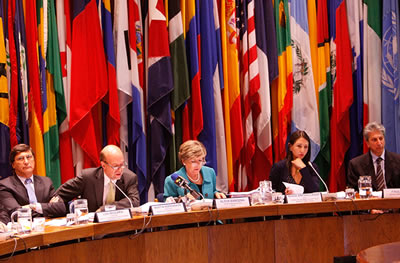Poverty and Indigence Levels Are the Lowest in 20 Years in Latin America
Work area(s)
The Organization predicts that the region will close this year with three million people less living in poverty.

(29 November 2011) Today, the Economic Commission for Latin America and the Caribbean (ECLAC) reported that between 1990 and 2010 the poverty rate in Latin America dropped by 17 percentage points (from 48,4% to 31,4%) , while the indigence rate fell by 10.3 percentage points (from 22,6% to 12,3%). Therefore, both indicators are at their lowest levels in 20 years.
The publication Social Panorama of Latin America 2011 presented in Santiago, Chile, by the Executive Secretary of ECLAC, Alicia Bárcena, states that the poverty level will drop to 30.4% in 2011, while the indigence rate will increase slightly to 12.8% because the rise in food prices would counteract the predicted rise in household incomes.
This means that the region will close this year with 174 million inhabitants living in poverty, 73 million of which are living in extreme poverty or indigence. In 2010, there were 177 million poor, 70 million of which were living in indigence.
According to ECLAC, the decrease in poverty is primarily due to an increase in labour income. Public monetary transfers also contributed, but to a lesser extent.
"Poverty and inequality continue to decline in the region, which is good news, particularly in the midst of an international economic crisis. However, this progress is threatened by the yawning gaps in the productive structure in the region and by the labour markets which generate employment in low-productivity sectors, without social protection," warned Alicia Bárcena.
Between 2009 and 2010, significant drops in poverty rates were observed in five countries: Peru, Ecuador, Argentina, Uruguay and Colombia.
Honduras and Mexico were the only countries with significant rises in their poverty rates (1.7% and 1.5% respectively). As for Mexico, the comparison was made with the poverty rate for 2008; therefore, the figure does not only reflect the economic growth in Mexico in 2010, but also the major GDP per capita contractions in 2009.
The publication also highlights that the improvement in distribution was not affected following the economic crisis. Between 2008-2010 in Mexico, Venezuela and Uruguay, the Gini index dropped to an annual rate of over 2% and in El Salvador and Peru it was over 1% per year.
Furthermore, the Social Panorama of Latin America 2011 reveals that public expenditure, and in particular social expenditure, has increased significantly over the past 20 years in the region.
The lowest spending per capita (less than US$ 300) is in Bolivia, Ecuador, Guatemala, Honduras, Nicaragua and Paraguay. These countries spend the most on education. However, in the countries which have social spending per capita of over US$ 1,000, such as Argentina, Brazil, Chile, Costa Rica, Cuba, Trinidad and Tobago and Uruguay, the most spending is on social security and assistance.
In response to the global economic crisis, the countries opted to temporarily expand public spending rather than to shrink it, which was the action traditionally taken. Although, the emphasis is not always placed on society, expansion still prevented the rise in unemployment and social vulnerability.
The ECLAC study also analyses in depth the existing gaps in the world of work and social protection in Latin America.
Not all employees in formal work are enrolled in the social security system: only 4 out of every 10 workers make contributions.
Households with larger numbers of family members, female heads of house and located in rural sectors are those which have less access to contributory protection in the region. Likewise, in 12 out of 17 countries analysed, the social security and pension contributions benefit less than half of older persons.
According to ECLAC, in the medium and long term many countries should reform their social security schemes again to take steps towards rights-based social protection systems, based on contributory and non-contributory finance mechanisms supporting the distribution of resources.
Otherwise, there will continually be problems relating to financing universal social protection in ageing societies with a smaller workforce.
"To jointly improve productive convergence, labour institutionality and universal social protection in Latin America, steps towards fiscal pacts and social dialogue must be taken," stated Ms. Bárcena.
The ECLAC publication also discusses the situation of fertility in Latin America. Over the past 50 years, the global fertility rate observed dropped rapidly, compared with the moderate drop in adolescent fertility. In addition, a chapter on the Caribbean has been included for the first time, which warns of the high level of unemployment and the incidence of HIV/AIDS among young people in the subregion.
See also:
- Briefing paper. Social Panorama of Latin America 2011.
- Graph. Latin America: Evolution of poverty and indigence, 1980-2011.
- Table. Persons living in poverty and extreme poverty, 18 countries, 2002-2010.
- Presentation by ECLAC Executive Secretary, Alicia Bárcena
Any queries should be addressed to the ECLAC Public Information and Web Services Section. E-mail: dpisantiago@cepal.org; Telephone: (56 2) 210 2040.
Follow us on: Twitter, Facebook, Flickr and YouTube.
Related content
Social Panorama of Latin America 2011
Presentation by ECLAC Executive Secretary, Alicia Bárcena
Country(ies)
- Latin America and the Caribbean
-
Chile
Contact
Public Information Unit
- prensa@cepal.org
- (56 2) 2210 2040